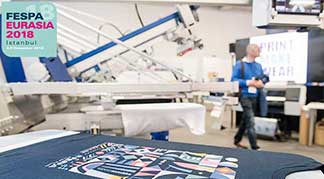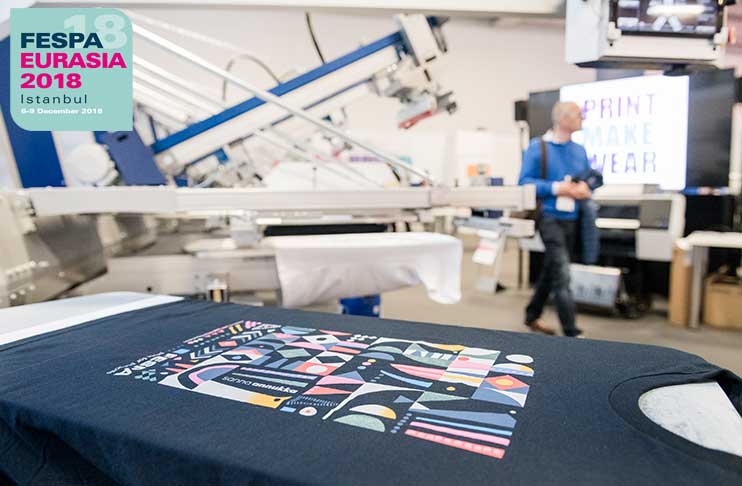
According to FESPA’s 2018 Print Census, inkjet textile printing applications continue to offer meaningful growth potential for many print businesses. The research found that 39% of graphics producers are looking for textile printing capability when they invest.
The Census also illustrated that currently digital adoption for textile is slower than in other segments and production is still dominated by analogue processes. However, among printers with a focus on textile, 56% have made digital investments and 19% plan to do so in the next two years. This represents an exciting high-growth market opportunity for print service providers (PSPs).
According to research from Smithers Pira, commissioned by FESPA to explore the key trends shaping this sector, the value of digitally printed textile will nearly quadruple between 2012 and 2021, reaching $2.46 billion by the end of the nine year period. This contrasts positively with the conventional (non-textile) print market that as a whole is advancing at 1.2% year-on-year between 2015 and 2020.
Because of the substantial growth of textile, major print firms with a global presence are now entering this market, adding smaller specialist firms to their technology portfolios. This increases the demand for digital textile presses, which has a knock-on effect on suppliers of consumables and post-press equipment. As this continues, bespoke technology solutions revolving around inkjet are under constant development.
New opportunities in inkjet textile printing
The increase in digital inkjet textile printing can be viewed as a response to demand from key segments: clothing, household textiles, displays and signage and technical textiles. In 2016 clothing was the largest segment by volume (50.5%), followed by displays and signage, household and technical textiles. This correlates with the results from our FESPA 2018 Census results, which showed that garment products dominate across all textile businesses, with sports apparel, textiles for garments and fast fashion topping the growth applications ‘leader board’.
Soft signage (banners, flags and similar visual communications) continues to show promise as a segment where the creative freedom of digital production is evidently value-adding, with a growth rate expected of 13.7% between 2016 and 2021, pushing the market value to $658 million.
Representing 70 million square metres of printed fabric and with a value of $89 million globally in 2016, household textiles encompassing upholstery, carpets and floor coverings, bed linen and curtains is a fast developing market segment. The household textiles segment is also predicted to take market share from technical and display textiles in the coming years.
Technical textiles (digitally printed fabrics used in functional or industrial contexts and where decoration is not the primary motivator) is the smallest and least dynamic of the digital textile print end-use segments. Worth $57 million in 2016, it is forecast to climb to $100 million in 2021, at a year-on-year growth rate of 12%. While smaller and slower growing than the other key areas, technical textiles still has clear opportunities for both generalist and specialist PSPs, with automotive fabrics and protective clothing both expanding beyond the mean rate.
Printed fashion – dressed for success
In terms of both volume and value, clothing remains the largest segment for digitally printed textile; with a global market worth $770 million and representing 440 million square metres of fabric in 2016. Sportswear is the most lucrative sub-segment of the market – equating to a 27.6% share in 2016 ($213 million); which can be accounted for by the popularity of polyester-based materials. Fashion and haute couture – $112 million and €98 million in 2016 – are also significant sub-segments with lucrative customer bases and together represent another 27.2% market share.
Investment in high-end digital inkjet textile printing equipment is allowing fashion cycles to accelerate, delivering photo realistic images and bespoke detailed garments. Fast turnaround on digital presses means shorter initial runs can be ordered. This allows retailers to place swift re-orders on fast-selling stock; resulting in reduced warehousing costs and less risk of wastage of unsold inventory. For online retailers this model can be extended even further; with garments printed in very short runs as soon orders have been placed. Speed is the key priority in textile, similarly to other segments. The FESPA Print Census showed that faster production is the driver for investment for 69% of textile print businesses.
These developments align neatly with the changing nature of the fashion industry. A more competitive and interconnected world of fashion consumption means that the industry has now moved well beyond the traditional two-season (Spring/Summer, Autumn/Winter) model. Instead each of these can now be divided into multiple mini-seasons, with new collections and launches for each.
Changing trends in the fashion industry are also the key drivers behind new direct-to-garment presses; optimised for different types of clothing. Service providers in the garment customisation sector can leverage the capabilities of these machines to enhance their print offering; while advances in web-to-print ordering and job management software allow them to adopt just-in-time (JIT) delivery approaches to support their business. In fact, the fashion industry is discovering that a JIT model has multiple benefits; in terms of cash flow, investment, reduction in stock holding, minimisation of warehouse space and general operational efficiencies.
Ink & Tech
As PSPs examine the opportunities in the inkjet textile printing sector; there is increased demand for hardware and ink combinations that are; efficient, cost-effective to install, and offer the potential to upgrade as business develops.
True volume growth will be driven by the adoption of a new class of mass production roll-to-roll (RTR) digital inkjet textile printing machines. The trend to higher productivity per printer is reflected in the fact that; while the installed base will rise by 76% between 2016 and 2021; the total output by volume will rise by a remarkable 124%. World print equipment sales for digital textile printing will double over this five year period; from $811 million to $1.63 billion. Such a sharp productivity boost can be attributed to larger print firms entering the textile market; by acquiring smaller dedicated textile print companies; many of which are located in Northern Italy and China.
One important limitation for digital textile printing is the reliance on synthetic polyester fabrics; which are necessary for the inks from dye sublimation printers to bind to. The most promising solution is to evolve pigment inks beyond technical and signage applications to open new markets in various clothing sub-segments. Pigment is flexible and can be used to print on almost all fabrics; so new inks are being launched for textile that have the ability to adhere to a range of substrates; such as cotton, silk, polyester and lycra.
What lies ahead
It is an exciting time for digital textile printing. Textile service providers are seeing their markets expand in parallel to wider industry changes that favour digital printing; like lower print runs and a premium on customisation. This coincides with a growing willingness to embrace new business models.
However, despite rapid growth, there is still room for expansion in the fabric production industry; which is supported by consumer trends including the evolution of fast fashion and online ordering. For volume production, new, faster roll-to-roll platforms will allow inkjet to take work from screen presses.
It will be interesting to see what innovations suppliers will bring to FESPA Eurasia 2018 next month.
PSPs interested in textile printing will be able to attend the first Print Make Wear Istanbul feature at FESPA Eurasia 2018. Following its successful launch at FESPA Global Print Expo 2018; the feature will showcase all stages in the garment production process from design to the finished garment.
Visitors will also be able to engage directly with experts on-hand in the feature. Print Make Wear Istanbul will highlight both digital and screen print technologies; including the latest design and workflow software, direct to textile printing and a live screen printing automatic and manual production illustrating special effects.
FESPA Eurasia takes place from 6 to 9 December 2018 at IFM Exhibition Centre, Istanbul. For more information and to register to attend, visit www.fespaeurasia.com. For free entry into the exhibition use code EURM802.
The figures in this article (unless otherwise referenced) are taken from the FESPA/Smithers Pira White Paper ‘ Inkjet Textile Printing ‘.
The full research report is available to members of FESPA’s national Associations or FESPA Direct members. For details of membership, contact Emma Tuddenham, FESPA at [email protected].
By-lined to Michael Ryan, Group Exhibition Manager, FESPA


